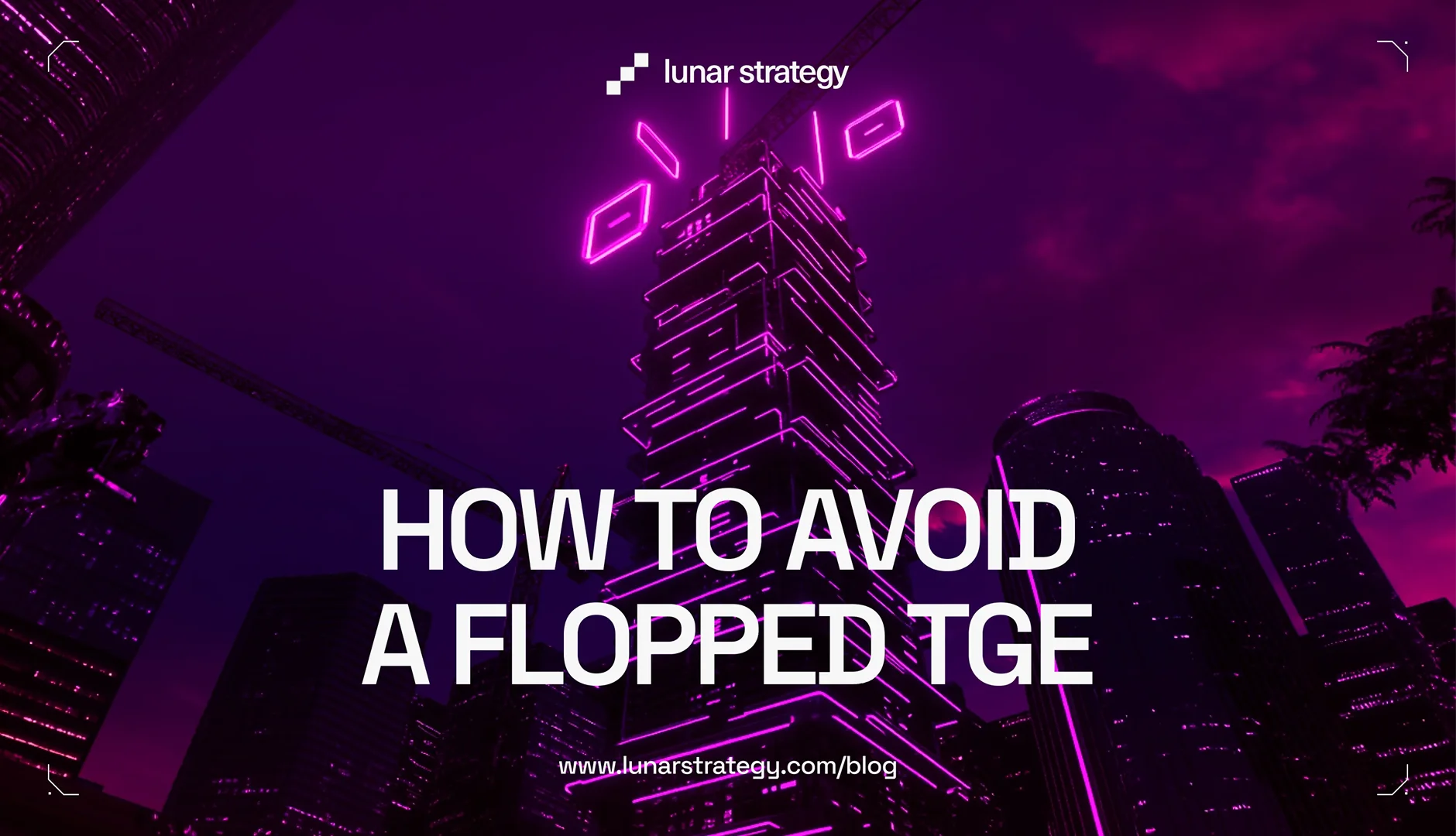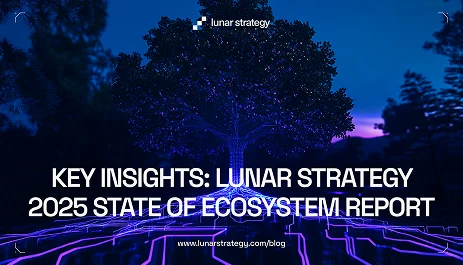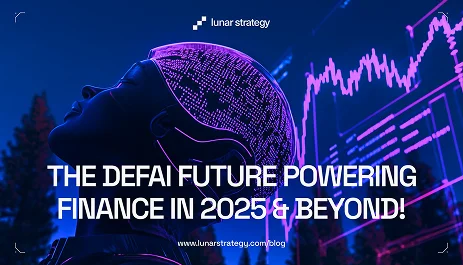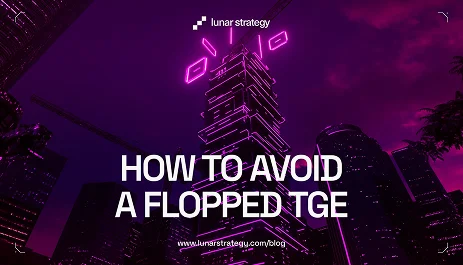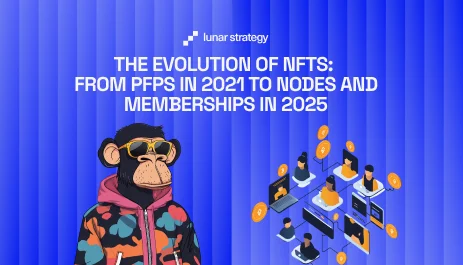In 2024, over 5,300 new crypto tokens hit the market daily—yet most faded into obscurity.
Cut to 2025, and Token Generation Events (TGEs) have shed their taken over the ICO narrative. Today, they’re more disciplined, community-driven, and fiercely competitive. Success is about delivering tech that actually works, economics that make sense, and communities that stick around long-term.
This article breaks down what it takes to nail a TGE in 2025, we'll spotlight trends like DeFi, DePIN, and AI + Crypto, dissecting wins and flops, and showing how firms like Lunar Strategy tilt the odds in your favor.
The New Rules of TGEs
A TGE is a project’s big reveal—its basically a chance to introduce a blockchain token to the world, much like an IPO in traditional finance. In the multichain crypto ecosystem of today, the stakes are higher than ever, and success means a lot of things must go right. The tech has to be rock-solid: smart contracts need thorough audits to prevent disasters (like the $600M Poly Network hack of 2021), and the infrastructure must handle launch-day traffic—trust us, nothing kills credibility faster than a crashed website.
Tokenomics need to be tight too.
Investors scrutinize Fully Diluted Valuation (FDV), the total market cap if all tokens were circulating, and they’re quick to ditch projects with inflated numbers—like StarkNet’s $6.9B FDV with only 13% in circulation back in 2022, which triggered a rapid sell-off. Beyond the numbers, a genuine community is essential.
As a web3 project, you won't be taken seriously if you fake it with bot-filled Discords; instead, real engagement through testnets, AMAs, and governance trials to build a crowd that’s invested in the vision will count for more value. Legal compliance rounds out the must-haves—KYC checks, geo-blocking, and careful wording keep regulators at bay in an increasingly watchful landscape.
Winning TGEs don’t happen by accident—they follow a strategic playbook. Projects mix private sales with public airdrops to balance venture capital interest with grassroots support, tap into trending narratives like AI + Crypto for momentum, and secure reputable partners to boost credibility. Timing is critical too; launching during a Bitcoin dip can sink even the best ideas. When these elements align, a TGE stands a real shot at breaking through the noise.
Hot Verticals: Where the Action Is
Three sectors dominate the TGE landscape, each offering unique opportunities and challenges. DeFi has evolved beyond the days of unsustainable 1,000% APYs that inevitably crashed.
Today, investors demand “real yield”—profits derived from actual protocol fees rather than speculative gimmicks. Airdrops remain a powerful tool to draw in users, though 88% of projects without them flop; smart lock-up periods help prevent the dump-and-run behavior that plagued earlier launches. Security is non-negotiable—one hack can erase trust overnight—making models like Uniswap’s fee-sharing approach a benchmark for keeping token holders engaged.
Decentralized Physical Infrastructure Networks (DePIN) take a different path, bridging blockchain and digital space with real-world utility.
Projects like Helium, which powers wireless networks through token incentives, require patience as hardware deployment lags behind software timelines. Success depends on strong community buy-in, as seen with OpenEnergy Network, where tokens tied to solar power output deliver tangible value that outshines fleeting hype. It’s a slower burn, but the payoff can be substantial for those who stick it out.
Meanwhile, AI + Crypto is the breakout star of 2025, with DeFAI (AI-driven DeFi) leading the charge. Investors have grown skeptical of vague “AI-powered” claims and now expect concrete results. Virtuals Protocol’s 26,596% surge in 2024 came from delivering usable AI tools for developers, not just buzzwords. DeFAI’s promise of autonomous yield farming that outsmarts human traders is gaining traction, with projects like AlphaGrail showcasing AI vaults that hint at the future. Each vertical has its own demands—trust for DeFi, vision for DePIN, and proven substance for AI + Crypto—but precision in execution is what sets winners apart.
TGE Case Studies: Hits and Misses
Real-world examples show what works—and what implodes, let's take a quick look:
- Arbitrum (Hit) Arbitrum’s success as Ethereum’s leading Layer-2 solution came down to its community-first approach. Instead of a traditional sale, the project opted for a strategic airdrop that targeted active users and developers within the Ethereum ecosystem. This move ensured tokens landed in the hands of those already invested in the project’s success, fostering loyalty and a sense of ownership. Arbitrum’s governance model further cemented this bond by giving token holders a direct say in key decisions, from protocol upgrades to fee structures.The result? A deeply engaged community that stuck around. Add to that Arbitrum’s battle-tested technology—handling over 40% of Ethereum’s traffic at its peak—and the token had a rock-solid foundation. Unlike many launches that fizzle after the hype, Arbitrum’s token held its value and became a cornerstone of the Layer-2 ecosystem. The takeaway: aligning incentives with users and delivering proven tech pays off.
- Virtuals Protocol (Hit) Virtuals Protocol rode the AI + Crypto wave to a jaw-dropping 26,596% surge in 2024, but it wasn’t luck—it was execution. The platform delivered real, usable AI tools that solved developer pain points, like AI-driven smart contract auditing that slashed the time and cost of securing code. Another standout was its automated market-making algorithms, which optimized liquidity strategies for DeFi users. These were solutions devs needed. The tokenomics were equally sharp, rewarding builders and long-term participants through staking and governance incentives. By aligning the token’s value with the platform’s utility, Virtuals Protocol created a flywheel of adoption and growth. Its success underscores a critical lesson for 2025: in AI + Crypto, substance beats hype every time.
- Sui (Miss) Sui had all the ingredients for success—cutting-edge tech and big-name backers—but its launch imploded under the weight of its own ambition. A gated sale process locked out retail investors, breeding resentment, while a sky-high $10 billion Fully Diluted Valuation (FDV) set expectations the project couldn’t meet. As token unlocks flooded the market, the price cratered, and community trust evaporated. Sui’s failure wasn’t in its technology but in its execution: overvaluation and exclusionary tactics alienated the very users it needed. The lesson is brutal but clear—hype without follow-through is a fast track to irrelevance. These cases boil down to a simple truth: community, utility, and restraint win TGEs. Arbitrum and Virtuals Protocol thrived by engaging users and delivering real value, while Sui’s missteps led to a swift downfall. Flashy launches and VC stamps mean nothing without a foundation of trust and execution.
Arbitrum and Virtuals Protocol thrived by engaging users and delivering value.
Sui flopped by ignoring them. In 2025, TGEs need execution, not just big names or buzz.
Introducing the Lunar TGE Accelerator
To tackle the challenge of how projects approach TGE's head-on, Lunar Strategy created the Lunar Strategy TGE Accelerator 2025 program. This program is designed specifically for pre-TGE projects in the L1, L2, DeFi, and DePIN spaces, as well as funded dev teams. Here’s what it offers:
- Tailored Go-To-Market Strategy: A plan that’s built around your project’s unique needs.
- Access to a Verified Network: Over 1,000 crypto Key Opinion Leaders (KOLs) ready to boost your launch.
- Proven PR Campaigns: Media coverage and public relations tactics that actually work.
- Design & Social Media Expertise: To craft a narrative that resonates and stands out.
- Sustainable Growth Foundations: Helping you build the robust technical and community infrastructure you need.
Just as every skyscraper relies on its foundation to weather storms and time, a successful TGE depends on aligning every piece—from your technical groundwork to your market positioning. Lunar Strategy’s approach ensures that each layer is solid, reducing the risks of that critical launch phase.
Lunar Strategy partners with projects that demonstrate a clear product-market fit, offer a tangible working prototype or MVP, and have a solid technical foundation. They value teams that tackle real user problems and already boast an engaged, active community.
For projects that meet these criteria and are ready to leave TGE failures behind, the Lunar TGE Accelerator offers a proven roadmap to success. If you’re prepared to build on a foundation that can truly support your vision, it’s time to join forces with Lunar Strategy.
Apply now and set your project up for success in any cycle, bull or bear!











